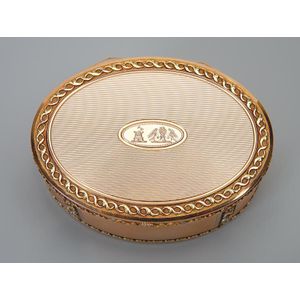Moonstone and Diamond Earrings with Rose Cut Surrounding
You must be a subscriber, and be logged in to view price and dealer details.
Subscribe Now to view actual auction price for this item
When you subscribe, you have the option of setting the currency in which to display prices to $Au, $US, $NZ or Stg.
- Oxidised (finish in Jewellery) - An oxidised finish in jewellery, particularly gold, refers to a surface treatment that intentionally darkens or blackens the metal surface to create an antique or vintage look. The process involves using a chemical solution to speed up the natural tarnishing or corrosion of the metal, resulting in a dark, matte or semi-matte finish.
In gold jewellery, oxidised finishes are typically applied to lower karat gold alloys, such as 14k or 18k gold, rather than higher karat gold, such as 22k or 24k gold. This is because lower karat gold alloys contain more base metals, such as copper, which are more reactive and prone to tarnishing.
Oxidised finishes in gold jewellery can create a wide range of looks, from a subtle aged patina to a more dramatic blackened finish, depending on the strength and duration of the chemical treatment. This type of finish can add depth and character to jewellery designs, and is often used to create contrast between different elements or textures in a piece. - Rose Cut - A flat based cut for a preious stone, leaving the surface covered with triangular facets, usually 24 in total.
It was introduced in the 15th century and popular during the 16th and 17th centuries.
The rose cut was the most popular form of diamond cut until the discovery of the brilliant cut at the end of the 17th century, after which its use declined. - Cabochon Cut in Jewellery - A cabochon cut is a type of gemstone cutting where the stone is cut and polished in a convex shape with a flat bottom and a domed top, with no facets. This type of cut is typically used for opaque or translucent stones that have natural patterns or inclusions that are best displayed in this type of cut. Examples of stones that are often cut as cabochons include turquoise, opal, and moonstone.
This item has been included into following indexes:
Visually similar items

A Victorian gold-silver-lined locket and two Victorian rolled-gold miniature frames. (3)

Pair 18ct yellow gold and opal cufflinks approx 9 grams

A German four-colour gold snuff box, Hanau, late 18th century, oval, the surface finely reeded within coloured gold interlacing foliate borders, the side panels alternating with trailing roses, the centre of the cover engraved with later crests, the interi

Peter Lange, Commonwealth Games Auckland 1990 commemorative plate, together with three other stoneware plates. Diameter 21 cm
